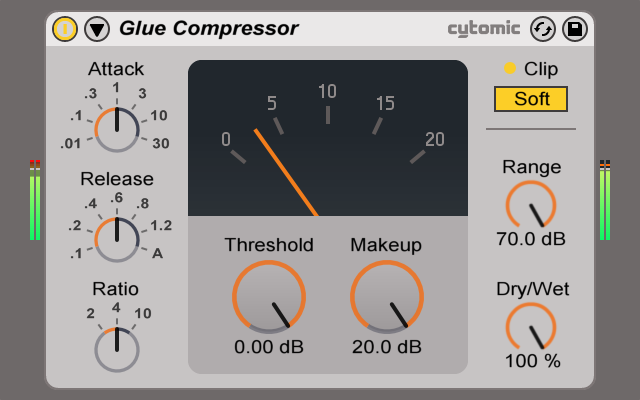
The Glue Compressor of Ableton is not only a superb sounding compressor it can also be used as a soft clipper device. It can overdrive the signal like crazy while the device will never ever go over 0 dB. And without compression or limiting! Try this at home or in your studio:
- Add a Glue Compressor on a mixer channel.
- Activate the Soft button on the Glue.
- Keep the threshold at 0 dB so the Glue won’t start compressing.
- Optional: turn on Oversampling.
- Now when you increase the Makeup gain the device will start producing soft clipping saturation (odd harmonics) but will never go over 0 dB.
This method makes perfect sense and works great on the Master channel to keep it from going over 0 dB. If you want a little more headroom for MP3 compression for example, put a Utility device after the Glue and put the Gain of this Utility device somewhere between – 0.3 dB and – 1 dB.
Of course it makes perfect sense to apply some compression from the Glue, this in combination with the Soft Clip option makes it a great sounding alternative to the classic Limiter which can often be found at the end of a Master bus.
What about Hard Clipping?
By default Live will hard clip the sound when you go over 0 dB. Red lights on the meter will light up to warn you. Some people though like hard clipping. It creates odd harmonics which are squared waves and extremely harsh sounding. Soft clipping on the other hand rounds the waves like a tape machine would do (tape = odd harmonics).
Don’t forget: there are no rules. Happy experimenting! 😀

4 Comments
thanks for this Marco. i have been having fun all morning..did you make a typo though? It seems to say both hard and soft clipping result in odd harmonics? Whereas soft =even harmonics?
No typo, hard and soft clipping are both causing odd harmonics. It’s just that hard clipping creates more overtones, more in the upper range (7, 9, 11, 13 and so one).
You can simply check this yourself. Take a pure sine wave. It will create one peak frequency, no harmonics. Now change this to a square wave and see how the odd harmonics which will be added. tot he original peak frequency. You get the same results when clipping the sine wave.
The 808 bass drum gets clipped a lot in productions. What they are doing is turning the 808 bass drum (which is a sine wave) into a squared wave 🙂
By Post Author
ahhh..I knew this in 1981! Time for the memory pills….I just did a nice (haha) track with that effect and a ring modulator/bent analog delay and Glue..just scared my dog. thanks again Marco.
I have no dog but I could have scared him this morning. Took out my old tube amp, putting the speaker output into the Palmer Speaker sim, but only used the unfiltered output and ran it through some custom Impulse Responses I did recently. Blew my mind. Tube amp + IR is king I guess 😀
By Post Author